History of Aerial Warfare
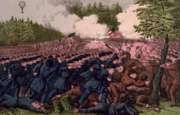
|
|

|
|
Aerial warfare is the use of military aircraft and other flying machines in warfare, including military airlift of cargo to further the national interests as was demonstrated in the Berlin Airlift. Developing from unpowered observation hot air balloons in the 18th century and even older Kite, aerial warfare has become a high-technology affair that has led to many advances in technology and techniques such as propulsion, radar, and use of composites and engineered materials such as carbon fibers.
Kite warfare
The earliest documented aerial warfare took place in ancient China, when a manned Kite was set off to spy for military intelligence and communication. Ancient Chinese soldiers also mounted massive aerial fire arrow attacks from war kites, where they would send a volley of flaming arrows from the war kite onto the ground target.
Balloon warfare
Balloon warfare in Ancient China
In or around the 2nd or 3rd century, a prototype Hot air balloon, the Kongming lantern was invented in China serving as military communication.
Balloon warfare in Europe
Some minor warfare use was made of balloons in the infancy of aeronautics. The first instance was by the French Aerostatic Corps at the Battle of Fleurus in 1794, who used a tethered balloon, L'entreprenant, to gain a vantage point.
Balloons had disadvantages. They could not fly in bad weather, fog, or high winds. They were at the mercy of the winds and were also very large targets.
American Civil War
Union Army Balloon Corps

(Image: Battle of Fair Oaks with one of Lowe's balloons in the background)
The American Civil War was the first war to witness significant use of aeronautics in support of battle. Thaddeus Lowe made noteworthy contributions to the Union war effort using a fleet of balloons he created. In June 1861 Professor Thaddeus S. C. Lowe left his work in the private sector as a scientist/balloonist and offered his services as an aeronaut to President Lincoln, who took some interest in the idea of an air war. Lowe's demonstration of flying his balloon Enterprise over Washington, DC, and transmitting a telegraph message to the ground was enough to have him introduced to the commanders of the Topographical Engineers; initially it was thought balloons could be used for preparing better maps.
Lowe's first action was at the First Battle of Bull Run in July 1861 with General Irvin McDowell and the Grand Army of the Potomac. Enterprise did a free flight observation of the Confederate positions.
In another demonstration, Lowe was called to Fort Corcoran by artillery General W. F. Smith. Lowe ascended to a given altitude in order to spot rebel encampments at Falls Church, Virginia. With flag signals he directed artillery fire onto the sleeping encampment. As the General put it, "The signals from the balloon have enabled my gunners to hit with a fine degree of accuracy an unseen and dispersed target area."
By October, Lowe had orders in hand to build four balloons with portable hydrogen gas generators for use in aerial reconnaissance. Working with several other prominent American balloonists he formed the Union Army Balloon Corps who never received commissions, working as civilian contractors, This was of great concern should the aeronauts be shot down over enemy lines, as civilian spying is summarily punishable by death. Therefore Lowe instructed on the strict use of tethered (as opposed to free) flight. By attaining altitudes from 1,000 feet (300 m) to as much as 3-1/2 miles, an expansive view of the battle field and beyond could be had.
Lowe built seven balloons: Eagle, his first; Constitution, one of the smaller balloons; its sister, Washington; Intrepid, a larger balloon and his favorite; a sister, Union; Excelsior; and United States, which never came out of storage.
As the Confederates retreated toward Richmond, the War turned into the Peninsular Campaign. Due to the heavy forests on the peninsula, the balloons were unable to follow on land. Lowe was introduced to George Washington Parke Custis, a coal barge converted to operate balloons. The balloons and their gas generators were loaded aboard and taken down the Potomac, where reconnaissance of the peninsula could continue. Custis was taken up the Pawmunkey River, where Lowe was reunited with McClellan's army.
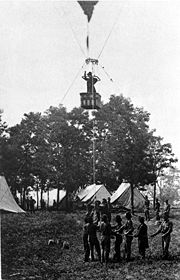
(Image: Prof. Lowe ascending in Intrepid to observe the Battle of Fair Oaks)
Lowe's most dramatic action came in the Battle of Fair Oaks, where he was able to view the advancing of Lee's army onto the isolated detachment of General Heintzelman. Working from two balloon camps, one at Mechanicsville and one at Gaine's Farm, Lowe galloped six miles (10 km) twice daily to keep up with the reconnaissance reports. McClellan was sure the rebels were feigning an attack, but Lowe could see differently. Heintzelman was left stranded on the other side of the Chickahominy River with the bridges having been taken out overnight by the swollen waters. Lowe sent a dispatch of utmost urgency to have the bridge repaired immediately and reserves sent to Heintzelman's aid. He then sent dispatch from Mechanicsville to Gaine's Farm calling for the immediate inflation of the large balloon Enterprise, which would aid him in overlooking the imminent battle.
When Lowe arrived at Gaine's Farm, Intrepid will still far from being inflated. In a quick work of inventive ingenuity, Lowe had the bottom of a camp kettle cut out and joined the valve ends of the Intrepid and the partially inflated Constitution hooked together, thereby transferring the gas from the latter into the former. Within 15 minutes he was in the air to oversee the battle.
Lowe fell prey to malaria during Fair Oaks and was out of commission for more than a month. On his return he found the Balloon Corps had been stripped of horses and wagons and left out of service for Antietam. Lowe was called back into service at Sharpsburg and later responded to Gen. Burnside's army at Vicksburg. The ensuing defeat of the Union Army in what was referred to as the "Mud March" led to Gen. Joseph Hooker relieving Burnside. By this time, the Balloon Corps had been assigned to the Engineers Corps, and a newly promoted Captain Comstock cut Lowe's pay dramatically.
Lowe tendered his resignation and was released from military duty in May 1863. The Balloon Corps continued to operate with Lowe's handlers, but Union generals' continuing ignoring and mistrust of ballooning resulted in balloon-intelligence not being utilized. By August, the Union Army Balloon Corps was disbanded.
Silk Dress Balloons
Due to the effectiveness of the Union Army Balloon Corps, the Confederates felt compelled to incorporate balloons as well. As coke gas was not always available in Richmond, the first balloons were made of the Montgolfier rigid style, cotton stretched over wood framing and filled with hot smoke from fires made of oil-soaked pinecones. They were piloted by Captain John R. Bryant for use at Yorktown. Though Bryant's performance was not all that bad, his handlers were poorly experienced and his balloon was left in the air spinning like a top. Another incident had one of the handlers becoming entangled in the ascending tether rope which had to be chopped loose, leaving the Captain free-flying over his own Confederate positions whose troops threatened to shoot him down.
Attempts at making gas-filled silk balloons were hampered by the South's inability to obtain any imports at all. They did fashion a balloon from dress silk (purportedly silk for making dresses, not from silk dresses themselves). The inflated spheres appeared as multi-colored orbs over Richmond and were piloted by Captain Landon Cheeves. Before the first balloon could be used it was captured during transportation on the James River by the crew of the Monitor. A second balloon did see action until summer 1863, when it was blown from its mooring and taken by Union forces only to be divided up as souvenirs for members of the Federal Congress. As the Union Army reduced its use of balloons, so did the Confederates—much to their relief.
Zeppelins, airships and blimps
As powered aircraft with wings dominated military aviation during WWI, rigid dirigibles and zeppelins were used by the Germans to attack cities. After WWI, the United States Navy researched the use of airships, including their use as a base for fighter aircraft, but efforts were cancelled after losses in storms. In WWII, barrage ballons were used as obstacles against aircraft, and blimps were used as observation and radar platforms.
Before World War I
The armies of many countries evaluated the use of aircraft for observation purposes. Naval aviation was pursued as well; several tests were made in which floatplanes were launched by catapult from ships at sea, and recovered later by crane.
The U.S. Navy had been interested in naval aviation since the turn of the 20th century. In August 1910 Jacob Earl Fickel did the first experimenting with Glenn Curtiss shooting a gun from an airplane. In 1910-1911, the Navy conducted experiments which proved the practicality of carrier-based aviation. On November 14, 1910, near Hampton Roads, Virginia, civilian pilot Eugene Ely took off from a wooden platform installed on the scout cruiser USS Birmingham (CL-2). He landed safely on shore a few minutes later. Ely proved several months later that it was also possible to land on a ship. On January 18, 1911, he landed on a platform attached to the American cruiser USS Pennsylvania (ACR-4) in San Francisco harbor.
The first use of airplanes in an actual war occurred in the 1911 Italo-Turkish War with the Italian Army Air Corps bombing a Turkish camp at Ain Zara, Libya, and in the 1912 First Balkan War with the Bulgarian Air Force bombing Turkish positions at Adrianople. Airplanes were also used by the U.S. against Pancho Villa. Air reconnaissance was carried out in both wars too. The first air-dropped bomb in military history was developed by Captain Simeon Petrov of the Bulgarian Air Force, extensively used during the First Balkan War (including in the first ever night bombing on 7 November 1912), and subsequently shared with the Imperial German Air Service during World War I.
World War I
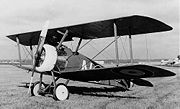
(Image: RAF Sopwith Camel during World War I)
Initially during that war both sides made use of tethered balloons and airplanes for observation purposes, both for information gathering and directing of artillery fire. A desire to prevent enemy observation led to airplane pilots attacking other airplanes and balloons, initially with small arms carried in the cockpit, but due to the technology of the time pilots couldn't have forward facing machine guns.
Although the addition of deflector plates to the back of propellers by French pilot Roland Garros and designer Raymond Saulnier in the Morane-Saulnier monoplane was the first example of an aircraft able to fire through its propeller, it wasn't until the Dutch aircraft designer Anthony Fokker developed the interrupter gear in 1915 that it became possible to aim the gun and the airplane at the same time. Eventually the Allies were able to capture a Fokker Eindekker with an interrupter mechanism intact and reverse engineer it, leading to the birth of aerial combat, more commonly known as the dogfight. Tactics for dogfighting evolved by trial and error. Eventually the German ace Oswald Boelcke created eight essential rules of dogfighting, the Dicta Boelcke. Both sides also made use of aircraft for bombing, strafing, sea reconnaissance, antisubmarine warfare, and dropping of propaganda. The German military made use of Zeppelins and, later on, bombers such as the Gotha, to drop bombs on Britain.
By the end of the war airplanes had become specialized into bombers, fighters, and observation (reconnaissance) aircraft.
Between the wars
Between 1918 and 1939 aircraft technology developed very rapidly. In 1918 most aircraft were biplanes with wooden frames, canvas skins, wire rigging and air-cooled engines. Biplanes continued to be the mainstay of air forces around the world and were used extensively in conflicts such as the Spanish Civil War. Most industrial countries also created air forces separate from the army and navy. However, by 1939 military biplanes were in the process of being replaced with metal framed monoplanes, often with stressed skins and liquid cooled engines. Top speeds had tripled; altitudes doubled; ranges and payloads of bombers increased enormously.
Some theorists, especially in Britain, considered that aircraft would become the dominant military arm in the future. They imagined that a future war would be won entirely by the destruction of the enemy's military and industrial capability from the air. The Italian general Giulio Douhet, author of The Command of the Air, was a seminal theorist of this school, which has been associated with Stanley Baldwin's statement that "the bomber will always get through"; that is, regardless of air defenses, sufficient raiders will survive to rain destruction on the enemy's cities. This led to what would later be called a strategy of deterrence and a "bomber gap", as nations measured air force power by number of bombers.
Others, such as General Billy Mitchell in the United States, saw the potential of air power to augment the striking power of naval surface fleets. German and British pilots had experimented with aerial bombing of ships and air-dropped torpedoes during World War I with mixed results. The vulnerability of capital ships to aircraft was demonstrated on 21 July 1921 when a squadron of bombers commanded by General Mitchell sank the ex-German battleship SMS Ostfriesland with aerial bombs; although the Ostfriesland was stationary and defenseless during the exercise, its destruction demonstrated the potency of airplanes against ships.
It was during the Banana Wars, while fighting bandits, freedom fighters and insurgents in places like Haiti, the Dominican Republic and Nicaragua, that United States Marine Corps aviators would begin to experiment with air-ground tactics making the support of their fellow Marines on the ground their primary mission. It was in Haiti that Marines began to develop the tactic of dive bombing and in Nicaraugua where they began to perfect it. While other nations and services had tried variations of this technique, Marine aviators were the first to embrace it and make it part of their tactical doctrine.
Germany was banned from possessing an air force by the terms of the WWI armistice. The German military continued to train its soldiers as pilots clandestinely until Hitler was ready to openly defy the ban. This was done by forming the Deutscher Luftsportverband, a flying enthusiast's club, and training pilots as civilians, and some German pilots were even sent to the Soviet Union for secret training; a trained air force was thus ready as soon as the word was given. This was the beginning of the Luftwaffe.
World War II
Military aviation came into its own during the Second World War. The increased performance, range, and payload of contemporary aircraft meant that air power could move beyond the novelty applications of WWI, becoming a central striking force for all the combatant nations.
Over the course of the war, several distinct roles emerged for the application of air power.
Strategic bombing
Strategic bombing of civilian targets from the air was a first proposed by the Italian theorist General Giulio Douhet. In his book The Command of the Air (1921), Douhet argued future military leaders could avoid falling into bloody World War I-style trench stalemates by using aviation to strike past the enemy's forces directly at their vulnerable civilian populations. Douhet believed such strikes would cause these populations to force their governments to surrender.
Douhet's ideas were paralleled by other military theorists who emerged from World War I, including Sir Hugh Trenchard in Britain. In the interwar period, Britain and the United States became the most enthusiastic supporters of the strategic bombing theory, with each nation building specialized heavy bombers specifically for this task.
Imperial Japanese Air Service
Sh?wa strategic bombing was independently conducted during the Second Sino-Japanese war and World War II by the Imperial Japanese Navy Air Service and the Imperial Japanese Army Air Service.
Bombing efforts mostly targeted large Chinese cities such as Shanghai, Wuhan and Chonging. The bombing of Nanjing and Canton, which began on 22 and 23 September 1937, called forth widespread protests culminating in a resolution by the Far Eastern Advisory Committee of the League of Nations.
There were also air raids on Philippines and northern Australia (Bombing of Darwin, 19 February 1942). The Imperial Japanese Navy Air Service used tactical bombing against enemy airfields and military positions, as at Pearl Harbor. The Imperial Japanese Army Air Service also attacked enemy ships and military installations.
Luftwaffe
In the early days of WWII, the Luftwaffe launched devastating air attacks against the besieged cities of Warsaw and Rotterdam. In the case of Warsaw, the bombings had little effect, but in the case of Rotterdam, the psychological effect of the bombings did have the intended effect—a relatively rapid ending of Dutch resistance (Buckley 129).
During the Battle of Britain, the Luftwaffe, frustrated in its attempts to gain air superiority in preparation for the planned invasion, turned to bombing of London and other large English cities. However, the Luftwaffe found these raids did not have the effect predicted by prewar airpower theorists.
Royal Air Force
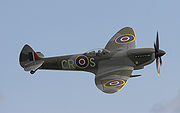
(Image: The Spitfire played a vital part for British victory in the Battle of Britain.)
The British, started in kind - using a strategic bombing campaign in 1940 that was to last for the rest of the war. Early British bombers were all twin-engined designs and were lacking in defensive armament. Therefore, Bomber Command quickly turned to a policy of night bombing, for which the crews were untrained; their inaccuracy meant they were forced to adopt area bombing and were unable to hit specific targets such as factories or power plants until later in the war when pathfinder tactics, radio location plus ground mapping radar (OBOE and H2S) and very low-level bombing such as that used by the Dambusters in Operation Chastise were developed.
Soviet Red Air Force
Although the rapid industrialization the Soviet Union experienced in the 1930s had the potential to enable the Voyenno-vozdushnyye sily (VVS) to be effective against the Luftwaffe, Stalin's purges left the organization intellectually and morally weakened. However, when Germany invaded in June 1941 (Operation Barbarossa), the massive size of the VVS, in both planes and people, allowed it to absorb "horrendous" casualties and still maintain capability.
Like Japan was to do in December of that year, Nazi Germany had awoken a sleeping giant which was too large to destroy despite the Wehrmacht's superior experience and the Luftwaffe's superior training. Despite the near collapse of both the Red Army and Red Air Force, Germany's 1941 assault failed to destroy either one, and as the massive resources of the Soviet Union were reorganized toward war, Germany's impending destruction become ever more apparent.
As during the Battle of Britain, fundamental flaws in the Luftwaffe were exposed during Germany's war with the Soviet Union. Although strategic bombing requires that the enemy's industrial war capacity be neutralized, some Soviet war factories were moved as much as 1,000 miles (1,600 km) east—far out of reach of the Luftwaffe's bombers. And even factories and VVS facilities that were in reach of the Luftwaffe had to be ignored much of the time because the Luftwaffe's resources were needed for more critical duty in supporting the German army. The Luftwaffe became overstretched, and even victorious battles damaged the overall capability of Germany's air force due to attrition.
By 1943, the Soviets had fully rebounded from the defeats of 1941, and they were able to produce considerably more airplanes than their German rivals; for example, at Kursk, the VVS had twice the number of airplanes that the Luftwaffe had. The VVS's fighter-capability rested on the Yakovlev Yak-9 and Lavochkin La-5, and its primary bombers were the Ilyushin 2 Shturmovik and Petlyakov Pe-2. Utilizing overwhelming numerical superiority, Soviet forces were able to drive the Germans out of Soviet territory and take the war to Germany.
U.S. Army Air Force
When the U.S. Eighth Air Force arrived in England in 1942, the Americans were convinced they could carry out successful daylight raids. The Eighth was equipped with B-17 Flying Fortresses and B-24 Liberators, both high-altitude four-engined designs. The new bombers also featured the strongest defensive armament yet seen - up to 13 .50 caliber machine guns, depending on the version, most of them in power-operated turrets. Flying in daylight in large, close formations, U.S. doctrine held tactical formations of heavy bombers would be sufficient to gain air superiority in the absence of escort fighters. The intended raids would hit hard on chokepoints in the German war economy such as oil refineries or ball bearing factories.
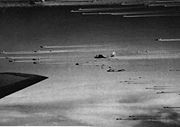
(Image: Part of a USAAF stream of over 1,000 B-17 bombers.)
The U.S.A.A.F. was compelled to change its doctrine since bombers alone, no matter how heavily armed, could not achieve air superiority against single-engined fighters. Loss rates rose from five to twenty per cent in a series of missions between August 17 and October 14, 1943, when raids against Regensburg and Schweinfurt, penetrating beyond the range of fighter cover, resulted in the loss of 60 bombers on one mission.
Air superiority
During the Battle of Britain, many of the best Luftwaffe pilots had been forced to bail out over British soil, where they were captured. As the quality of the Luftwaffe fighter arm decreased, the Americans introduced the long-range P-38 Lightning and P-51 Mustang escort fighters, carrying drop tanks. Newer, inexperienced German pilots—flying potentially superior aircraft, such as the Focke-Wulf Fw 190, Heinkel He 162, and the Messerschmitt Me 262—gradually became less and less effective at thinning the late-war bomber streams. Adding fighters to the daylight raids gave the bombers much-needed protection and greatly improved the impact of the strategic bombing effort.
Over time, from 1942 to 1944, the Allies' air forces became stronger and stronger while the Luftwaffe became weaker and weaker. During 1944, the Luftwaffe experienced a 78 percent reduction in its strength, and Germany's air force lost control over Germany's skies. As a result nothing in Germany could be securely protected—not stationary army units, nor moving army units, nor war factories, nor their workers, nor civilians in cities such as Hamburg and Dresden, nor the nation's capital—Berlin. Germans had to watch as their soldiers and civilians began to be slaughtered in the thousands by aerial bombardment—much as the Germans had done to Poland, Rotterdam, Britain, and the Soviet Union.
Effectiveness
Strategic bombing by non-atomic means did not win the war for the Allies, nor did it succeed in breaking the will to resist of the German (and Japanese) people. But in the words of the German armaments minister Albert Speer, it created "a second front in the air." Speer succeeded in increasing the output of armaments right up to mid-1944 in spite of the bombing. Still, the war against the British and American bombers demanded enormous amounts of resources: antiaircraft guns, day and night fighters, radars, searchlights, manpower, ammunition, and fuel. On the Allied side, strategic bombing diverted material resources, equipment (such as radar) aircraft, and manpower away from the Battle of the Atlantic (where even a couple of squadrons of B-24s could be priceless) and Allied armies. As a result, German army groups in Russia, Italy, and France rarely saw friendly aircraft and constantly ran short of tanks, trucks, and anti-tank weapons. The only option left was to create World War I-style slit trench defenses quite unlike the blitzkriegs of 1939-1941.
Tactical air support
By contrast with the British strategists, the primary purpose of the Luftwaffe was to support the Army. This accounted for the presence of large numbers of dive bombers on strength and the scarcity of long-range heavy bombers. This 'flying artillery' greatly assisted in the successes of the German Army in the Battle of France (1940). Hitler determined air superiority was essential for the invasion of Britain. When this was not achieved in the Battle of Britain, the invasion was canceled, making this the first major battle whose outcome was determined primarily in the air.
The war in Russia forced the Luftwaffe to devote the majority of its resources to providing tactical air support for the beleaguered German army. In that role, the Luftwaffe used the Junkers Ju 87, Henschel Hs 123 and modified fighters—Bf 109 and FW 190.
The Red Air Force was also primarily used in the tactical support role, and towards the end of the war was very effective in the support of the Red Army in its advance across Eastern Europe. An aircraft of importance to the Soviets was the Ilyushin Il-2 Sturmovik—appropriately called "flying artilery"; the Il-2 was able to make life very difficult for panzer crews, and the Il-2 was an important part of the Soviet victory at Kursk—one of the biggest tank battles in history.
Military transport aviation and use of airborne troops
Military transport aviation was invaluable to all sides in maintaining supply and communications of ground troops, and was used on many notable occasions such as resupply of German troops in and around Stalingrad after Operation Uranus, and employment of airborne troops. After the first trials in use of airborne troops by the Red Army displayed in the early 1930s many European nations and Japan also formed the airborne troops, and these saw extensive service on in all Theatres of the Second World War. However their effectiveness as shock troops employed to surprise enemy static troops proved to be of limited success. Most airborne troops served as light infantry by the end of the war despite attempts at massed use in the Western Theatre by US and Britain during the Operation Market Garden.
Naval aviation
Aircraft and the aircraft carrier first became important in naval battles in World War II, particularly:
Battle of Taranto
Attack of Pearl Harbor
Sinking of Prince of Wales and Repulse, the first time a battleship underway was sunk solely by aircraft
Battle of the Coral Sea, the first where neither fleet was in visual contact with the other and all fighting was carried out by aircraft
Battle of Midway
Battle of the Bismarck Sea
Battle of the Philippine Sea
Battle of Leyte Gulf, the first appearance of kamikazes; perhaps the largest naval battle in history
Battle of the Atlantic, carrier aircraft used for antisubmarine patrol, defense, and attack
Cold War Era
Military aviation in the post-war years was dominated by the needs of the Cold War. The post-war years saw the almost total conversion of combat aircraft to jet power, which resulted in enormous increases in speeds and altitudes of aircraft. Until the advent of the Intercontinental Ballistic Missile major powers relied on high-altitude bombers to deliver their newly-developed nuclear deterrent; each country strove to develop the technology of bombers and the high-altitude fighters that could intercept them. The concept of air superiority began to play a heavy role in aircraft designs for both the United States and the Soviet Union.
The Americans developed and made extensive use of the high-altitude observation aircraft for intelligence-gathering. The U-2, and later the SR-71 Blackbird were developed in great secrecy. The U-2 at its time was supposed to be invulnerable to defensive measures, due to its extreme altitude. It therefore came as a great shock when the Soviets downed one piloted by Gary Powers with a surface-to-air missile.
Air combat was also transformed through increased use of air-to-air guided missiles with increased sophistication in guidance and increased range.
In the 70s and 80s it became clear that speed and altitude was not enough to protect a bomber against air defences. The emphasis shifted therefore to maneuverable attack aircraft that could fly 'under the radar', at altitudes of a few hundred feet.
Korean War
United Nations forces used air power including jets against communist ground forces in Korea. But they were seriously challenged by the appearance of Russian supplied swept-wing MiG-15 fighters. The F-86 Sabre was America's only swept-wing fighter able to wrest back air superiority.
India-Pakistan War of 1965
The war saw the Indian Air Force and the Pakistani Air Force being involved in full scale combat for the first time since independence. Though the two forces had previously faced off in the First Kashmir War during the late 1940s, it was limited in scale compared to the '65 conflict.
Both countries hold highly contradictory claims on combat losses during the war and hardly any neutral sources have thoroughly verified the claims of both countries' claim. PAF claimed it had shot down 104 IAF planes losing only 19 in the process. India meanwhile claimed that 35 IAF planes were lost while shooting down 73 PAF aircraft.
Pakistan's main strike force comprised the U.S. made F-86 Sabre jets, which claimed a fair share of Indian planes, though remaining vulnerable to the dimunitive Folland Gnat, nicknamed "Sabre Slayer". The PAF's F-104 Starfighter was by far the fastest fighter on the subcontinent at that time. On the other hand, the Indian Air Force relied largely on the Hawker Hunter for attacks. Unlike the PAF, whose strength largely comprised American craft, IAF flew an assortment of planes from de Havilland Vampires to Dassault Mysteres, many of which were outdated in comparison to PAF planes, with even Gnats and Hunters being outmatched by Sabres and Starfighters. Some of the fiercest dogfights occurred over Sargodha, which was PAF's main base housing the bulk of its planes; IAF planes attacked the base but PAF was able to repulse the attacks. PAF responded by attacking Indian bases with some success, especially in air to ground attacks but were soon forced to back off, in order to provide cover for its ground troops elsewhere. In one incident, the Gujarat Chief Minister, Balawant Rai Mehta's civilian craft was shot down by PAF Sabres inside Indian territory, killing him and the crew. By the end of the war, neither the numerically larger IAF, nor the PAF which possessed a qualitative advantage, achieved air superiority.
Vietnam War
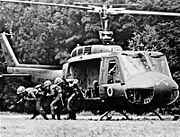
(Image: A UH-1D "Huey" seen offloading troops during the Vietnam War.)
Large scale use of helicopters by the US Army in Vietnam led to a new class of airmobile troops, and the introduction of "Air Cavalry" in the U.S, culminating in extensive use of the UH-1 Huey helicopter which would become a symbol of that war, while the CH-54 Tarhe "Skycrane" and CH-47 Chinook lifted heavier loads such as vehicles or artillery. Troops were able to land unexpectedly, strike, and leave again, and evacuate wounded. The specialized AH-1 Cobra was developed from the Huey for escort and ground support duties, The later Soviet campaign in Afghanistan would also see widespread use of helicopters as part of the Air Assault brigades and regiments.
US forces provided close support of ground force over South Vietnam, and strategic bombing of targets over North Vietnam. Many types flying close support or COIN (Counter Insurgency Warfare) missions were propeller powered types such as the O-1 and OV-10 Bronco FAC spotters, A-1 Skyraider, B-26 Invader, and AC-47"Spooky" gunship. C-123 Provider and C-130 Hercules transports flew supplies into battlefields such as Khe Sanh. "Fast movers" included the supersonic F-100 Super Sabre, while the giant B-52 Stratofortress would be modified to unload a massive high explosive payload on enemy troop concentrations. The AC-130 would become the ultimate gunship, while the AX specification to replace the Skyraider would evolve into the A-10 Thunderbolt II.
The USAF F-105 Thunderchiefs flew the bulk of strike missions against North Vietnam in Operation Rolling Thunder, while carrier-based A-4 Skyhawks were flown by the Navy. That first campaign was marred by carefully measured regulations that prohibited attacks against SAM missile sites and fighter bases, and frequent bombing halts, and produced little in political results. Rolling Thunder saw the first combat use of electronic computers aboard PIRAZ ships to display comprehensive real-time aircraft position information for force commanders.
Lessons learned were applied to the later Operation Linebacker which employed Phantoms, B-52s, swing-wing F-111s, A-7 Corsairs and all-weather A-6 Intruders was more successful in bringing North Vietnam to the negotiating table after a massive ground invasion. North Vietnam effectively combined Soviet and Chinese anti-aircraft artillery, SA-2 guided missiles, and MiG fighters to create the most heavily defended airspace up to that time.
US air strikes would combine the use of airbone radar platforms such as the C-121, KC-135s for air refueling, radar jamming aircraft and specialized "Wild Weasel" units to attack SAM missile sites. "Jolly Green Giant" helicopter crews escorted by A-1 "Sandy"s would retrieve downed pilots over hostile territory.With the use of "smart" guided bombs late in the war, this would set the model for future US air operations.
Experts were surprised when advanced F-105s were shot down in its first encounter against the elderly but nimble MiG-17. Dogfights were thought to be obsolete in the age of missiles, but pilots now needed maneuverability. The F-4 Phantom was quickly tasked with protecting against MiGs, but sorely lacked a built-in gun when missiles were often unreliable. Air combat training schools such as TOPGUN would improve kill ratios, but combat experience started programs that would produce agile air superiority fighters with guns such as the F-15 Eagle by the 1970s.
South Vietnam fell without US air support when faced with a massive assault in 1975. The VNAF South Vietnamese Air Force was never supplied with powerful fighters and bombers such as the Phantom and B-52 which could strike at North Vietnam.
Middle East
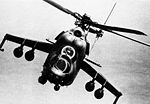
(Image: Soviet Mi-24 epitomized combat helicopter usage in aerial warfare during the Russo-Afghan war in the '80s)
In the Six-Day War of 1967, the Israeli Air Force launched pre-emptive strikes which destroyed opposing Arab air forces on the ground. The Yom Kippur War of 1973 saw the Arab deployment of mobile SA-6 missiles which proved effective against low-flying Israeli aircraft until they were neutralized by ground forces.
Post Cold War
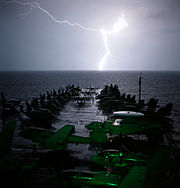
(Image: USS Abraham Lincoln rides out a storm in the Arabian Sea while on station in support of Operation Southern Watch and Operation Enduring Freedom.)
The collapse of the Soviet Union in 1991 forced Western air forces to undergo a shift from the massive numbers felt to be necessary during the Cold War to smaller numbers of multi-role aircraft. The closure of several military bases overseas and the U.S. Base Realignment and Closure program have served to highlight the effectiveness of aircraft carriers in the absence of dedicated military or air forces bases, as the Falklands war and U.S. operations in the Persian Gulf have highlighted. While the advent of precision-guided munitions have allowed for strikes at arbitrary surface targets once proper reconnaissance is performed (network-centric warfare). In some cases, such as the NATO Operation Allied Force effort against Serbian operations in Kosovo, air power was the deciding factor with ground forces mostly securing the area afterwards. However in most cases the standard military doctrine still applies: wars against third-world regional entities still cannot be won through air power alone.
Operation: Desert Storm
The role of air power in modern warfare was dramatically demonstrated during the Gulf War in 1991. Behind-the-lines air attacks were made on Iraqi command and control centers, communications facilities, supply depots, and reinforcement forces. Air superiority over Iraq was gained before major ground combat began.
The initial strikes were composed of Tomahawk cruise missiles launched from battleships situated in the Persian Gulf, F-117A Nighthawk stealth bombers with an armament of laser-guided smart bombs, and F-4G Wild Weasel aircraft armed with HARM anti-radar missiles. These first attacks allowed F-14, F-15, F-16, and F/A-18 fighter bombers to gain air superiority over the country and then continue to drop TV and laser-guided bombs. Armed with a gatling gun and heat-seeking or optically guided Maverick missiles, A-10 Thunderbolts bombed and destroyed Iraqi armored forces, supporting the advance of US ground troops. The AH-64 Apache and AH-1 Cobra attack helicopters, fired laser guided Hellfire missiles and TOW missiles which were guided to tanks by ground observers or scout helicopters. The allied air fleet also made use of the E-3A Airborne Warning and Control Systems (AWACS) and a fleet of B-52 bombers.
The aerial strike force was made up of over 2,250 combat aircraft, which included 1,800 US aircraft, which fought against an Iraqi force of about 500 Soviet-built MiG-29 and French-made Mirage F-1 fighters. More than 88,000 combat missions had been flown by allied forces with over 88,000 tons of bombs dropped by the end of the fifth week.
Operation: Iraqi Freedom
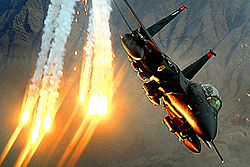
(Image: An F-15E Strike Eagle from the 391st Expeditionary Fighter Squadron at Bagram Air Base, Afghanistan, launches heat decoys during a close-air-support mission over Afghanistan, 15 December 2008)
During the 2003 invasion of Iraq led by US and British forces to defeat the regime of Saddam Hussein, aerial warfare continued to be decisive. The US-British alliance began its air campaign on March 19 with limited nighttime bombing on the Iraqi capital of Baghdad. Several days later, intensive bombardment began. About 14,000 sorties were flown, and at a cost of $1 million dollars each, 800 Tomahawk cruise missiles were fired at numerous targets in Iraq from March 19 until mid-April 2003. By this time Iraqi resistance had largely ended.
Iraqi anti-aircraft weapons were unable to open fire on high-altitude US bombers such as the B-52 or stealth aircraft such as the B-2 bomber and the F-117A. US and British aircraft used radar-detecting devices and aerial reconnaissance to locate Iraqi anti-aircraft weapons. Bunker buster bombs, designed to penetrate and destroy underground bunkers, were dropped on Iraqi command and control centers. Iraqi ground forces could not seriously challenge the American ground forces because of their air supremacy. By mid-April 2003, US-British forces controlled all of Iraq's major cities and oil fields.
2006 Lebanon War
In the beginning of the 2006 Lebanon War Israel utilized an intensive aerial campaign aimed to eliminate Hezbollah and destroy its military as stated by Israeli prime minister Ehud Olmert. It also aimed to return the kidnapped soldiers. The campaign started by destroying Lebanese infrastructure and Hezbollah targets. This continued during the 33 days of the war. The importance of this war to the history of aerial campaigns lies in the fact that its the first war in the modern history that didn't reach its goals through the use of air force. Taking into consideration the results of 1990 and 2003 wars on Iraq and 1998 war on former Yugoslavia; the Israeli air force, one of the strongest in the world, were unable to accomplish their objectives. This lies on the military doctrine that Hezbollah used in the war which proved effective in facing such kinds of wars. There have also been reports during the conflict that a Hezbollah-manned flying drone penetrated Israeli airspace, and returned to Lebanese territory.
Other conflicts
A few other spans of conflicts opened up the use of aerial warfare in recent times. In 1999, India and Pakistan were involved in a brief conflict over Kashmir. The Indian Air Force used Mirage 2000 fighter jet effectively to carry out ground assault sorties against Pakistani positions. The air operations were notable given the high altitude terrain of Kashmir.
Source: WikiPedia